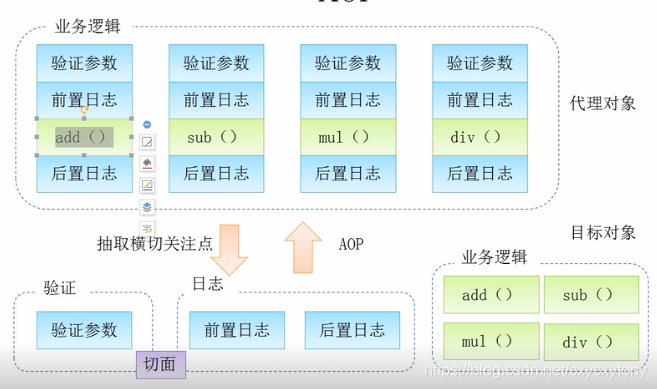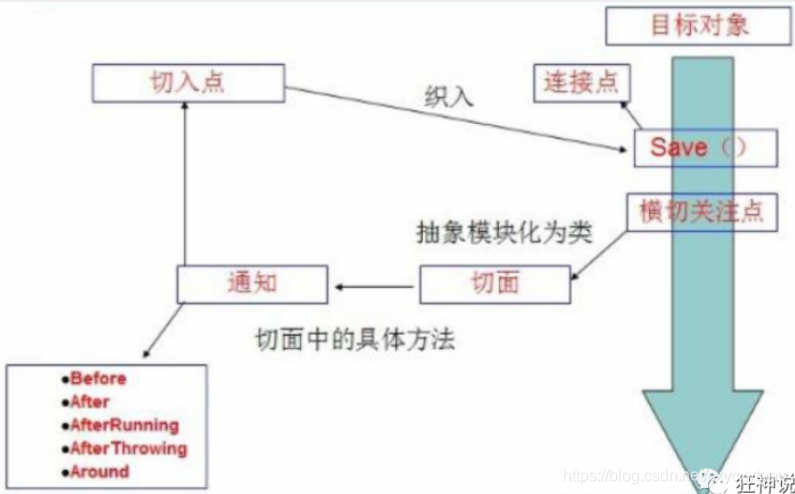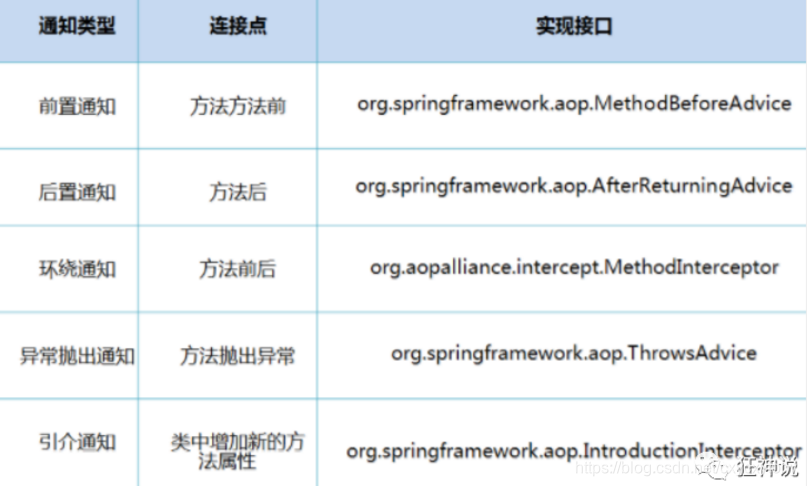文章目录
11.1、什么是AOP
AOP(Aspect Oriented Programming)意为:面向切面编程,通过预编译方式和运行期动态代理实现程序功能的同一维护的一种技术。AOP是OOP的延续,是软件开发中的一个热点,也是Spring框架中的一个重要内容,是函数式编程的一种衍生范型。利用AOP可以对业务逻辑的各个部分进行隔离,从而使得业务逻辑各部分之间的耦合度降低,提高程序的可重用性,同时提高了开发的效率。

11.2、AOP在Spring中的作用
提供声明式事务:允许用户自定义切面
以下名词需要了解:
- 横切关注点:跨越应用程序多个模块的方法或功能。即是,与我们业务逻辑无关的,但是我们需要关注的部分,就是横切关注点。如日志,安全,缓存,事务等等…
- 切面(ASPECT):横切关注点被模块化的特殊对象。即,它是一个类
- 通知(Advice):切面必须要完成的工作。即,它是类中的一个方法
- 目标(Target):被通知对象
- 代理(Proxy):向目标对象应用通知之后创建的对象
- 切入点(PointCut):切面通知执行的“地点”的定义
- 连接点(JointPoint):切入点匹配的执行点

SpringAOP中,通过Advice定义横切逻辑,Spring中支持5种类型的Advice

即Aop在不改变原有代码的情况下,去增加新的东西
11.3、使用Spring实现AOP
【重点】使用AOP织入,需要导入一个依赖包!
<dependency>
<groupId>org.aspectj</groupId>
<artifactId>aspectjweaver</artifactId>
<version>1.9.4</version>
</dependency>
11.3.1、方式一:通过Spring API实现
首先编写我们的业务接口和实现类
public interface UserService {
public void add();
public void delete();
public void update();
public void select();
}
public class UserServiceImpl implements UserService{
public void add() {
System.out.println("增加了一个用户");
}
public void delete() {
System.out.println("删除了一个用户");
}
public void update() {
System.out.println("跟新一个用户");
}
public void select() {
System.out.println("查询一个用户");
}
}
然后去写我们的增强类,我们编写两个,一个前置增强,一个后置增强
public class Log implements MethodBeforeAdvice {
//method:要执行的目标对象的方法
//objects:参数
//o:目标对象
public void before(Method method, Object[] objects, Object o) throws Throwable {
System.out.println(o.getClass().getName()+"的"+method.getName()+"被执行了");
}
}
public class AfterLog implements AfterReturningAdvice {
//returnValue:返回值
//method被调用的方法
//objects 被调用的方法的对象的参数
//o1 被调用的目标对象
public void afterReturning(Object returnValue, Method method, Object[] objects, Object o1) throws Throwable {
System.out.println("执行了"+method.getName()+";返回结果为:"+returnValue);
}
}
最后去Spring的文件中注册,并实现aop切入实现,注意导入约束
<?xml version="1.0" encoding="UTF-8"?>
<beans xmlns="http://www.springframework.org/schema/beans"
xmlns:xsi="http://www.w3.org/2001/XMLSchema-instance"
xmlns:aop="http://www.springframework.org/schema/aop"
xsi:schemaLocation="http://www.springframework.org/schema/beans
https://www.springframework.org/schema/beans/spring-beans.xsd
http://www.springframework.org/schema/aop
https://www.springframework.org/schema/aop/spring-aop.xsd">
<!-- 注测bean -->
<bean id="userService" class="com.chen.service.UserServiceImpl"/>
<bean id="log" class="com.chen.log.Log"/>
<bean id="afterLog" class="com.chen.log.AfterLog"/>
<!-- 方式一:使用原生Spring API接口 -->
<!-- 配置aop -->
<aop:config>
<!-- 切入点 expression:表达式,execution(要执行的位置!)-->
<aop:pointcut id="pointcut" expression="execution(* com.chen.service.UserServiceImpl.*(..))"/>
<!-- 执行环绕增加! -->
<aop:advisor advice-ref="log" pointcut-ref="pointcut"/>
<aop:advisor advice-ref="afterLog" pointcut-ref="pointcut"/>
</aop:config>
</beans>
补充:excuption(修饰符 返回值 包名.类名.接口名.方法名(参数列表))
修饰符可以不写,默认为public
*:代替可以为任意值
. .:代表所有参数
测试
public class MyTest {
public static void main(String[] args) {
ApplicationContext context = new ClassPathXmlApplicationContext("applicationContext.xml");
//动态代理的是接口:注意点
UserService userService = context.getBean("userService", UserService.class);
userService.add();
}
}
Aop的重要性:很重要,一定要理解其中的思路,主要是思想的理解。
Spring的Aop就是将公共的业务(日志,安全等)和领域业务结合起来,当执行领域业务时,将会把公共业务加进来,实现公共业务的重复利用,领域业务更加纯粹,程序员专注领域业务,其本质还是动态代理。
11.3.2、方法二:自定义类实现
自定义类来实现Aop
目标业务类不变依旧是userServiceImpl
第一步:写我们自己的一个切入类
public class DiyPointCut {
public void before(){
System.out.println("=======方法执行前=======");
}
public void after(){
System.out.println("=======方法执行后=======");
}
}
去Spring中配置
<?xml version="1.0" encoding="UTF-8"?>
<beans xmlns="http://www.springframework.org/schema/beans"
xmlns:xsi="http://www.w3.org/2001/XMLSchema-instance"
xmlns:aop="http://www.springframework.org/schema/aop"
xsi:schemaLocation="http://www.springframework.org/schema/beans
https://www.springframework.org/schema/beans/spring-beans.xsd
http://www.springframework.org/schema/aop
https://www.springframework.org/schema/aop/spring-aop.xsd">
<!-- 注测bean -->
<bean id="userService" class="com.chen.service.UserServiceImpl"/>
<bean id="log" class="com.chen.log.Log"/>
<bean id="afterLog" class="com.chen.log.AfterLog"/>
<!-- 方式二 -->
<bean id="diy" class="com.chen.diy.DiyPointCut"/>
<aop:config>
<!-- 自定义切面,ref要引用的类 -->
<aop:aspect ref="diy">
<!-- 切入点 -->
<aop:pointcut id="point" expression="execution(* com.chen.service.UserServiceImpl.*(..))"/>
<!-- 通知 -->
<aop:before method="before" pointcut-ref="point"/>
<aop:after method="after" pointcut-ref="point"/>
</aop:aspect>
</aop:config>
</beans>
测试:
public class MyTest {
public static void main(String[] args) {
ApplicationContext context = new ClassPathXmlApplicationContext("applicationContext.xml");
//动态代理的是接口:注意点
UserService userService = context.getBean("userService", UserService.class);
userService.add();
}
}
11.3.3、方法三:使用注解实现
使用注解实现
第一步:编写一个注解实现的增强类
import org.aspectj.lang.ProceedingJoinPoint;
import org.aspectj.lang.Signature;
import org.aspectj.lang.annotation.After;
import org.aspectj.lang.annotation.Around;
import org.aspectj.lang.annotation.Aspect;
import org.aspectj.lang.annotation.Before;
//方式三:使用注解方式实现AOP
@Aspect //标注这个类是一个切面
public class AnnotationPointCut {
@Before("execution(* com.chen.service.UserServiceImpl.*(..))")
public void before(){
System.out.println("*****方法执行前*****");
}
@After("execution(* com.chen.service.UserServiceImpl.*(..))")
public void after(){
System.out.println("*****方法执行后*****");
}
//在环绕增强中,我们可以给定一个参数,代表我们要获取处理切入的点
@Around("execution(* com.chen.service.UserServiceImpl.*(..))")
public void around(ProceedingJoinPoint pjd) throws Throwable {
System.out.println("******环绕前******");
Signature signature = pjd.getSignature();//获得签名,也就是这个类的信息
System.out.println("signature:"+signature);
//执行方法
Object proceed = pjd.proceed();
System.out.println("******环绕后******");
System.out.println(proceed);
}
}
第二步:在Spring配置文件中,注册Bean,并增加支持注解的配置
<?xml version="1.0" encoding="UTF-8"?>
<beans xmlns="http://www.springframework.org/schema/beans"
xmlns:xsi="http://www.w3.org/2001/XMLSchema-instance"
xmlns:aop="http://www.springframework.org/schema/aop"
xsi:schemaLocation="http://www.springframework.org/schema/beans
https://www.springframework.org/schema/beans/spring-beans.xsd
http://www.springframework.org/schema/aop
https://www.springframework.org/schema/aop/spring-aop.xsd">
<!-- 追测bean -->
<bean id="userService" class="com.chen.service.UserServiceImpl"/>
<bean id="log" class="com.chen.log.Log"/>
<bean id="afterLog" class="com.chen.log.AfterLog"/>
<!-- 方式三 -->
<bean id="annotationPointCut" class="com.chen.diy.AnnotationPointCut"/>
<!-- 开启注解支持 -->
<aop:aspectj-autoproxy/>
</beans>
第三步:测试
aop:aspectj-autoproxy:说明
通过aop命名空间的<aop:aspectj-autoproxy />声明自动为spring容器那些配置@aspect切
面的bean创建代理,织入切面。当然,spring在内部依旧采用
AnnotationAwareAspectJAutoProxyCreator进行自动代理的创建对象,但具体实现的细节已
经被<aop:aspectj-autoproxy />隐藏起来了
<aop:aspectj-autoproxy />有一个proxy-target-class属性,默认为false,表示使用
jdk(基于接口)动态代理织入增强,当配为<aop:aspectj-autoproxy proxy-target-class=true/>时
,表示使用CGLib(基于类)动态代理技术织入增强。不过即使proxy-target-class设置为false,如果目
标类没有声明接口,则spring将自动使用CGLib动态代理





 本文深入解析Spring框架中的AOP(面向切面编程)概念及其实现方式,包括通过Spring API、自定义类和注解三种方法,阐述了AOP在Spring中的作用,以及如何在不改变原有代码的情况下增加新功能。
本文深入解析Spring框架中的AOP(面向切面编程)概念及其实现方式,包括通过Spring API、自定义类和注解三种方法,阐述了AOP在Spring中的作用,以及如何在不改变原有代码的情况下增加新功能。
















 151
151

 被折叠的 条评论
为什么被折叠?
被折叠的 条评论
为什么被折叠?








